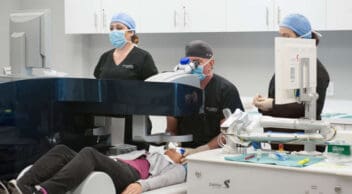
Medically Reviewed by Mujahid A. Hines, M.D. NVISION Surgeon
Radial Keratotomy vs. LASIK: A Comparison Guide
Home / Laser Eye Surgery Guide (Updated) /
Last Updated:

Medically Reviewed by Mujahid A. Hines, M.D. NVISION Surgeon
LASIK is the most famous and requested refractive error surgery, but it has only been around since the 1990s. Radial keratotomy helped some people with myopia in the 1980s, and in rare cases, this procedure may be recommended today.
Table of Contents
Although radial keratotomy was a huge advancement in treating myopia at the time, LASIK is safer, faster, less expensive, less invasive, and has a much higher rate of success compared to RK, making it a better choice for most people.
When asking your optometrist or ophthalmologist about outpatient surgical options to treat your refractive error, chances are high they will recommend LASIK. Even though RK is considered a dated procedure and rarely recommended, you can still ask about radial keratotomy if you think it will work better for your nearsightedness.
Radial Keratotomy vs. LASIK: Tracing a History of Refractive Error Surgeries

When you think about surgery that improves your vision by managing your refractive error, your first thought is probably about laser-assisted in situ keratomileusis (LASIK). This is a famous outpatient surgery involving a laser that reshapes your cornea, so light is refracted to the back of your eye. This improves the clarity of your vision, whether you are nearsighted, farsighted, or have astigmatism.
Although LASIK is the most famous version of this procedure, medical researchers have developed several methods for reshaping the cornea over the past several decades. One of the original procedures was radial keratotomy (RK), which was designed to help people with myopia, or nearsightedness, ranging from -1.00 to -4.00 diopters.
You deserve clear vision. We can help.
With 135+ locations and over 2.5 million procedures performed, our board-certified eye surgeons deliver results you can trust.
Your journey to better vision starts here.
Today, RK is considered an obsolete procedure. It is unlikely that your optometrist or ophthalmologist will recommend it. Despite this, there are some situations in which you may benefit from this operation.
Safety and Risks
All types of surgeries have risks of side effects and complications. Evidence over many years shows LASIK as a highly safe procedure with low complication rates. In fact, it is among the most studied and safest elective surgical procedures eye surgeons can perform today. Clinical data indicates that over 96 percent of patients report satisfaction with their results.
Potential side effects are mild. They include dry eyes, glares, haloes and double vision that usually resolve within three to 12 months. Rare potential complications include astigmatism, corneal inflammation, overcorrection and under correction.
Statistics show Radial Keratotomy as less safe than LASIK, a chief reason why eye surgeons today are unlikely to recommend it. Although radial keratotomy helped improve the vision of most patients who underwent the procedure, it is more invasive and not as precise as LASIK. As such, it carries a higher risk of side effects and serious complications.
Side effects from radial keratotomy include dry eyes, double vision, glares, haloes, light sensitivity and reduced night vision. Potential side complications from the procedure include diurnal fluctuation (hyperopic shift), corneal perforations, irregular astigmatism, farsightedness, refractive errors (overcorrection or under correction), infectious keratitis and ruptures of keratotomy scars.
To be fair, some of these complications develop years after patients undergo the procedure. Also, subsequent eye surgeries are more challenging to perform on patients who have undergone radial keratotomy. Needed follow-up procedures are not usually an issue for people who undergo LASIK surgery.
Recovery Time
The recovery period following LASIK eye surgery will vary from patient to patient and depends on several factors. Generally, the immediate recovery period is between six to 12 hours following the procedure.
Most people see clearly after 24 hours. Some patients can take two to five days for immediate recovery. However, it can take up to six months for your vision to fully stabilize following LASIK.
The recovery time of radial keratotomy also varies from patient to patient. Recovery is usually quick but not as fast as recovery following LASIK. Patients have to wear an eye patch after the procedure.
You can return to most normal activities within a few days. With LASIK, you can resume normal activities within 24 hours. After radial keratotomy, most patients experience blurry vision that can last for days or even weeks. Full recovery can take up to a year.
Will Your Eye Doctor Recommend Radial Keratotomy vs. LASIK?
When you talk to your eye doctor about refractive surgery, they will discuss one of the versions of LASIK — bladed versus bladeless LASIK, for example. They are unlikely to bring up radial keratotomy since there are better procedures and more recent devices that allow for faster, less invasive refractive improvements.
Radial keratotomy was an important step in refractive surgeries, allowing for advancements in the field that led us to where we are today. Some eye doctors will use it today in specific circumstances.
Radial Keratotomy
During this procedure, your eye surgeon makes small cuts in the cornea, in a radial or wheel-spoke shape, to flatten it. This can treat a specific range of nearsightedness, and it may also improve associated astigmatism.
Unlike LASIK and newer refractive procedures, radial keratotomy is only performed in one eye at a time. Your surgeon requires that you wait at least six weeks between operations, so they can be sure that the first procedure worked well and improved your vision. This delay ensures that you do not develop an infection that spreads to the other eye as well.
PROS
Throughout the 1980s and 1990s, radial keratotomy was a state-of-the-art procedure to improve myopia and, in some cases, astigmatism. The procedure is fast, taking between 10 and 15 minutes per eye, like LASIK in the modern era.
At its height of popularity, RK improved vision for most people who chose it: 85 percent of those who had RK reported that their vision improved to at least 20/40, and 53 percent reported that they had 20/20 vision after the operation. Only 30 percent reported using glasses or contact lenses again within 10 years following the procedure.
CONS
Although many people were successfully treated for nearsightedness, about 43 percent of those who underwent radial keratotomy developed farsightedness in the years after the operation — typically, within eight to ten years, but sometimes as soon as six months. This side effect is called a hyperopic shift.
There is also a slightly higher risk of overcorrection or undercorrection with radial keratotomy compared to modern laser-based refractive surgeries. And RK is less likely to fix myopia compared to LASIK or related procedures. You are more likely to continue to need glasses or contact lenses for some distance vision, or to begin to need them again within a few years following the surgery.
Although recovery after RK is quick, it is slower than with LASIK. You need about a week off from regular activities, although your sight returns within a day or two. You may have pain or throbbing in your eyes for one to four days after surgery. For three months to one year after surgery, your vision can vary slightly over the course of a day, which can impact driving or working.
LASIK

Approved by the U.S. Food and Drug Administration (FDA) in 1999, LASIK has allowed more people with different refractive errors to get long-term vision correction with little time in the operating room and a much faster healing time.
Rather than a series of small incisions in a circle on the cornea, LASIK uses a map of the cornea to remove pieces. A microkeratome, or small blade, creates a flap on the surface of the cornea. Then, a guided laser reshapes the internal structure.
The operation takes between 10 and 15 minutes per eye. Contrary to RK, your eye surgeon can correct both eyes on the same day.
PROS
LASIK has many benefits over other, older refractive surgeries. It improves a wide range of refractive errors, including farsightedness and primary astigmatism. It takes little time in the operating room, and it is less invasive, so healing takes less time. Many people who undergo LASIK return to work the next day, with exceptions for people who have physically taxing jobs.
Although there are some side effects that can last for up to six months, it is very rare for these issues to become disruptive. Millions of people around the world have undergone LASIK, and dozens of eye surgeons are well trained in these procedures. LASIK is easy to access, inexpensive compared to other refractive procedures, and effective. About 99 percent of people who have received LASIK report their vision reached at least 20/40 clarity; 90 percent report getting 20/20 or better vision.
CONS
People who have naturally thin corneas are not good candidates for the LASIK procedure. While they were not ideal candidates for radial keratotomy either, the RK procedure could accommodate a different range of corneal thickness.
One of the more frequently reported LASIK side effects is chronic dry eye, which may have several causes related to exposure to laser light. If you are prone to dry eyes anyway, LASIK can make this worse. If you did not have chronic dry eyes before, you may develop this condition.
While easy to manage with eye drops, dry eye can still be annoying and leave you feeling unsatisfied with your LASIK procedure. It is important to remember, however, that serious issues with dry eye due to LASIK are rare.
You deserve clear vision. We can help.
With 135+ locations and over 2.5 million procedures performed, our board-certified eye surgeons deliver results you can trust.
Your journey to better vision starts here.
LASIK Is the Better Option for More Refractive Errors Compared to Radial Keratotomy
LASIK is typically about $2,000 to $3,000 per eye, and you might get some insurance coverage depending on where you go and how comprehensive your vision insurance is. It is unlikely that you will get insurance coverage for radial keratotomy since there are more efficient, inexpensive, and less invasive refractive operations to choose from. Since you are unlikely to undergo RK, there is little financial information available on this procedure anymore.
Many people who wanted to reduce their myopia underwent radial keratotomy in the 1980s. Unfortunately, even though their corneas are considered healthy, they are not good candidates for LASIK now.
The surface changes from the RK incisions mean that it is harder for an eye surgeon to create a corneal flap. Even if your cornea is a standard thickness, you may not qualify for LASIK if you underwent RK a few decades prior.
Other refractive surgeries like photorefractive keratectomy (PRK) might work for you if your refractive error is serious enough. Ask your ophthalmologist about your options if you had RK a few decades ago, and your refractive error is changing.
Frequently Asked Questions (FAQs)
Is radial keratotomy the same as LASIK?
No. Radial keratotomy is different from LASIK in that the procedure involves using a diamond blade to reshape the cornea to correct refractive errors. LASIK surgery is performed using laser technology to improve visual acuity. LASIK is more precise and exhibits fewer complications than radial keratotomy.
Is radial keratotomy still performed?
Today, radial keratotomy is rarely recommended as a refractive surgery procedure. Developments in laser technology have made the procedure, which was common during the 1980s and 1990s, obsolete.
However, there are some select cases where this procedure can be beneficial. These cases include patients with mild to moderate myopia. However, knowledge of radial keratotomy is still relevant today. Some patients who underwent the surgical procedure still require visual rehabilitation years later.
What does radial keratotomy treat?
Radial keratotomy is used to treat myopia or nearsightedness and improve visual acuity. The incisions help flatten the center of the cornea allowing light to focus fully on the retinal screen. The result is a clear vision and the ability to see distant objects, resolving nearsightedness.
You deserve clear vision. We can help.
With 135+ locations and over 2.5 million procedures performed, our board-certified eye surgeons deliver results you can trust.
Your journey to better vision starts here.
References
- Radial Keratotomy: Surgical Procedure. (June 2013). Encyclopedia Britannica.
- Radial Keratotomy (RK) for Nearsightedness. (March 2017). Cigna.
- LASIK. (March 2018). U.S. Food and Drug Administration (FDA).
- What Is the LASIK Success Rate? (October 2017). American Refractive Surgery Council (ARSC).
- Post-LASIK Dry Eye. (August 2012). Expert Review Ophthalmology.
- Can I Have LASIK After Having Radial Keratotomy? (August 2014). American Academy of Ophthalmology (AAO).
- Is Lasik Safe? What You Need to Know. (October 2021). Refractive Surgery Council.
- Radial Keratotomy: Complications Management. (April 2021). American Academy of Ophthalmology.
- Meeting the Challenge of Post-RK Patients. (October 2007). Review of Ophthalmology.
- LASIK Eye Surgery: Recovery. (July 2020). Very Well Health.
- LASIK Eye Surgery Recovery: What to Expect. (December 2020). WebMD.
- Radial keratotomy surgical procedure. (May 2021). Britannica.

Mujahid Hines, M.D. is a board certified Comprehensive Ophthalmologist. He specializes in advanced refractive cataract surgery and LASIK and practices in Roseville and Folsom, California.
This content is for informational purposes only. It may have been reviewed by a licensed physician, but is not intended to serve as a substitute for professional medical advice. Always consult your healthcare provider with any health concerns. For more, read our Privacy Policy and Editorial Policy.
